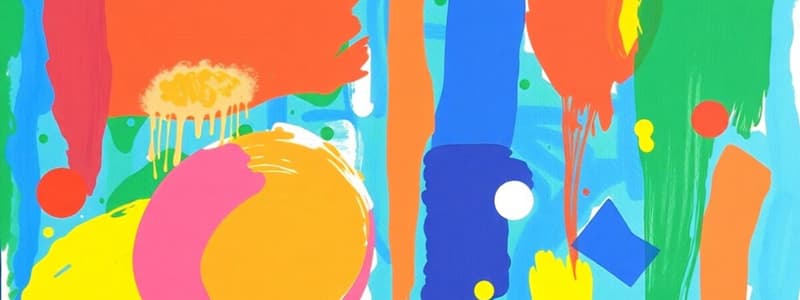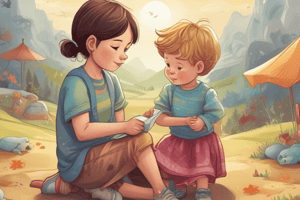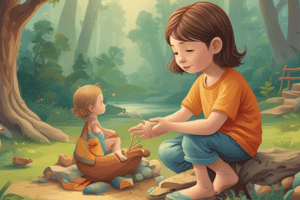Podcast
Questions and Answers
The emphasis in early childhood programs should be on the final product, rather than the learning process.
The emphasis in early childhood programs should be on the final product, rather than the learning process.
False (B)
A good program should be tailored to the collective needs of all children, rather than individual needs.
A good program should be tailored to the collective needs of all children, rather than individual needs.
False (B)
Encouraging children to copy existing models is key to fostering originality and independence.
Encouraging children to copy existing models is key to fostering originality and independence.
False (B)
Creative thinking involves stimulating imagination and problem-solving skills.
Creative thinking involves stimulating imagination and problem-solving skills.
All children should progress at the same rate in a well-designed program.
All children should progress at the same rate in a well-designed program.
Collage creation is most suitable for teenagers due to the complexity of the activity.
Collage creation is most suitable for teenagers due to the complexity of the activity.
Finger painting encourages sensory exploration and self-expression.
Finger painting encourages sensory exploration and self-expression.
Crayon drawings can help toddlers develop hand control and color recognition.
Crayon drawings can help toddlers develop hand control and color recognition.
Using permanent markers is recommended for toddlers during art activities.
Using permanent markers is recommended for toddlers during art activities.
Letting toddlers use scissors unsupervised is a safe way to encourage independence.
Letting toddlers use scissors unsupervised is a safe way to encourage independence.
Outdoor nature collages foster creativity and environmental awareness.
Outdoor nature collages foster creativity and environmental awareness.
Mud painting is a sensory experience that combines the natural world with creative expression.
Mud painting is a sensory experience that combines the natural world with creative expression.
Nature printing helps children understand patterns and textures.
Nature printing helps children understand patterns and textures.
Using rare, exotic flowers is essential for a successful nature printing activity.
Using rare, exotic flowers is essential for a successful nature printing activity.
Toxic mud should be used for mud painting to achieve the best color.
Toxic mud should be used for mud painting to achieve the best color.
Older preschoolers should only engage in indoor activities to minimize mess.
Older preschoolers should only engage in indoor activities to minimize mess.
Activities should aim to develop fine motor skills and teamwork if done in groups.
Activities should aim to develop fine motor skills and teamwork if done in groups.
Children should not be allowed to get dirty during art activities.
Children should not be allowed to get dirty during art activities.
The primary goal of art activities is to create perfect replicas of real-world objects.
The primary goal of art activities is to create perfect replicas of real-world objects.
Paintbrushes and sponges can be used in nature printing activities.
Paintbrushes and sponges can be used in nature printing activities.
Flashcards
Process, Not Product
Process, Not Product
Focus on the learning experience and skill development rather than just the final creation.
Needs of the Children
Needs of the Children
A program tailored to meet each child's individual needs, considering their development, interests and strengths.
Originality and Independence
Originality and Independence
Encouraging children to think for themselves and explore their own unique ideas.
Creative Thinking
Creative Thinking
Signup and view all the flashcards
Individualized Progress
Individualized Progress
Signup and view all the flashcards
Collage Creation
Collage Creation
Signup and view all the flashcards
Finger Painting
Finger Painting
Signup and view all the flashcards
Crayon Drawings
Crayon Drawings
Signup and view all the flashcards
Outdoor Nature Collage
Outdoor Nature Collage
Signup and view all the flashcards
Mud Painting
Mud Painting
Signup and view all the flashcards
Nature Printing
Nature Printing
Signup and view all the flashcards
Study Notes
- These notes cover program basics, goals, setup, and art activities for different age groups.
Program Basics: Goals and Setting Up
- Emphasis should be placed on the learning process rather than solely on the final product.
- Programs must be tailored to meet the individual needs of each child, considering their developmental stage, interests, and strengths.
- Encouraging children to think independently and explore their own ideas is important for building confidence and creativity.
- Programs should stimulate imagination and problem-solving skills.
- Recognize that every child progresses at their own rate, and programs should be flexible to accommodate these differences.
Art Activities for Toddlers (Ages 2-4)
Collage Creation (Construction Center)
- Uses scrap paper, fabric, buttons, glue, scissors (with supervision), and colored paper.
- Toddlers glue materials onto paper, encouraging fine motor skills and creativity.
- Supports decision-making as children select colors and textures.
- Learning goals include developing fine motor skills, promoting self-expression, and fostering hand-eye coordination.
Finger Painting (Curiosity Corner)
- Uses non-toxic finger paints, large paper sheets, aprons, and water for cleaning.
- Toddlers explore the tactile experience of finger painting and freely express themselves.
- Focus is on sensory experience rather than a finished product.
- Learning goals include encouraging sensory exploration, creativity, and self-expression.
Crayon Drawings (Sensory Corner)
- Uses crayons, textured papers, coloring books, or plain white sheets.
- Toddlers experiment with crayons on different paper textures.
- Helps develop fine motor skills and an understanding of textures.
- Learning goals include improving hand control, color recognition, and texture exploration.
Art Activities for Older Preschoolers (Ages 4-6)
Outdoor Nature Collage (Outside Environments)
- Uses leaves, sticks, stones, flowers, glue, and large paper.
- Children collect natural materials to create a nature collage.
- Encourages appreciation for nature and develops fine motor skills.
- Learning goals include fostering creativity, environmental awareness, fine motor skills, and teamwork (if done in groups).
Mud Painting (Outside Environments)
- Uses safe, non-toxic mud, paintbrushes, and paper or canvas.
- Children mix mud with water to create paint and make designs on paper.
- It’s an immersive sensory experience that combines nature with creative expression.
- Learning goals include sensory exploration, creativity, connection with nature, and fine motor development.
Nature Printing (Outside Environments)
- Uses leaves, flowers, branches, non-toxic paint, large paper, paintbrushes, and sponges.
- Children paint natural objects and press them onto paper to create prints.
- Helps understand patterns and textures while enhancing creativity.
- Learning goals include understanding patterns, texture exploration, and developing an interest in the natural environment.
Studying That Suits You
Use AI to generate personalized quizzes and flashcards to suit your learning preferences.




